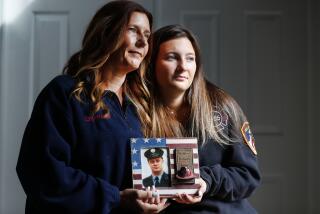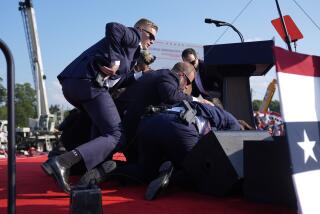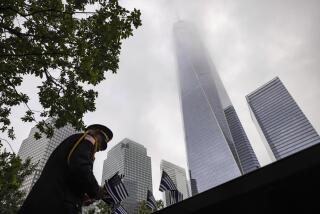U.S. Plan to Limit Flights on Sept. 11 Is Dropped
WASHINGTON — Bush administration officials scrambled Thursday to disavow and then undo proposed air travel restrictions for the Sept. 11 anniversary and, with commemorative events less than two weeks away, said broader security plans have not been finalized.
Stung by industry opposition to a proposal to prohibit foreign-owned airlines and private aircraft from flying into airports near last year’s three crash sites, officials first stressed that no final decision had been made and then, as the day progressed, concluded that the singling out of certain aircraft was probably illegal.
By the end of the day, officials had dropped the proposed restrictions on foreign-owned airlines but were still considering limits on general aviation aircraft at airports in and near New York City, Washington, D.C., and Somerset County, Pa., during certain periods from Sept. 11 through Sept. 13.
Officials said a plan could be finalized as soon as today.
In the meantime, the interagency flap exposed a security planning process that is surprisingly incomplete and a group of government agencies out of step, a rarity in the Bush administration.
“We constantly review our procedures,” said Secret Service spokesman John Gill, “and we are still in the process of putting together our plans for [Sept. 11]. Gill said the agency’s planning could not proceed until it received from the White House a fuller accounting of the president’s schedule.
President Bush will attend commemorative events at all three terrorist crash sites Sept. 11, beginning at the Pentagon before traveling to Ground Zero in New York City and to a memorial service in Shanksville, Pa., where United Flight 93 crashed into a field before it could reach its target.
Temporary airspace restrictions are routine when the president is traveling on Air Force One. But the Sept. 11 air security plans developed by a working group of officials from the Federal Aviation Administration, the Office of Homeland Security, the Defense Department, the North American Aerospace Defense Command, the Secret Service and the new Transportation Security Administration would go far beyond the ordinary.
Some individuals familiar with the working group described a clash of competing priorities. And while several officials pointed fingers at the FAA, others said the push for tighter airspace restrictions was driven by the Secret Service and military officials.
“The proposal was a result of consultations,” said FAA spokesman Les Dorr. “We were asked to implement whatever restrictions are decided on.”
In addition to the total ban on foreign-owned airlines, business jets, charters and single-engine planes, the proposal presented Tuesday to airline industry representatives also would have extended a restriction now imposed only on flights to and from Reagan National Airport to Dulles International and Baltimore-Washington airports as well. Passengers on flights to or from all three airports would not be allowed to stand or walk about the aircraft cabin for the first 30 minutes after departure or before arrival.
The development of special Sept. 11 security plans is not a response to specific intelligence information or terrorist threats, officials at several government agencies said Thursday.
The FBI has not received any specific information suggesting the possibility of further attacks on Sept. 11, and it did not relay any recommendation to the TSA to tighten security procedures, according to an FBI official who asked not to be identified.
“Whether this is being done out of an abundance of caution or what, we just don’t know,” the official said. “But we have not been advised of any particular [threats].”
Douglas Laird, former security director for Northwest Airlines and a former Secret Service official, said the government should not restrict air travel or other routines on Sept. 11.
“If you start changing patterns on Sept. 11,” he said, “you’re letting [the terrorists] win again. It sends a terrible message. If security is working, we shouldn’t have to change anything.”
But it was the proposed Sept. 11 restriction on foreign-owned airlines that provoked a strong outcry from industry and, according to a spokesman for British Airways, a disapproving communication from the British Embassy to the State Department.
Such country-specific travel restrictions, as well as United States-imposed security measures, are prohibited by both international and bilateral agreements, officials said.
“It’s against the law,” acknowledged Lenny Alcivar, spokesman for the Transportation Department.
The proposal was “premature and inconsistent with the views of the Bush administration ... a miscommunication by the FAA,” he said.
“The plans that were presented to us are clearly discriminatory,” said Wanda Warner, spokeswoman for the International Airline Transport Assn.
She said: “They invite foreign governments to take retaliatory action, and they seem to be based on the assumption that foreign airlines are not as safe as Ameri- can airlines, and that’s just not true.”
Ninety-four foreign airlines fly regularly scheduled service to the United States, she said.
Still under consideration is a temporary ban on general aviation travel in the three areas. In the New York area alone, that could ground as many as 12,000 corporate jets, said Warren Morningstar, spokesman for the Aircraft Owners and Pilots Assn.
“We haven’t been told of any specific security concerns that affect these aircraft and not other aircraft,” he said.
Violent anniversaries have sometimes brought more carnage--as in the Oklahoma City bombing on April 19, 1995, two years after the siege near Waco, Texas.
“As we get closer [to Sept. 11], there will probably be some sort of intelligence [bulletins] that will go out,” warning FBI field offices to be alert to danger signs, an FBI official said.
*
Times staff writer Eric Lichtblau contributed to this report.
More to Read
Sign up for Essential California
The most important California stories and recommendations in your inbox every morning.
You may occasionally receive promotional content from the Los Angeles Times.










